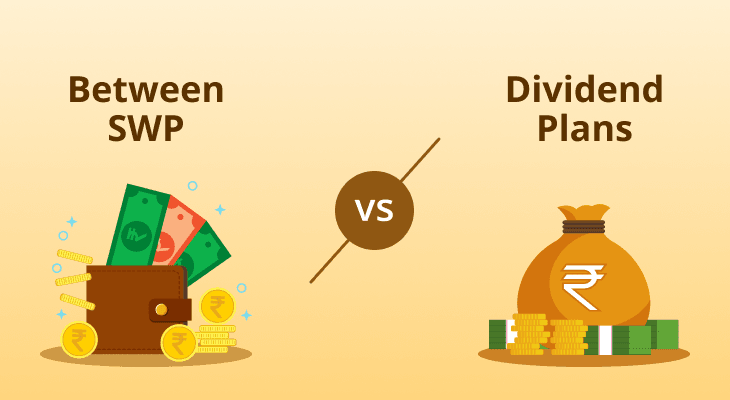
Payout Choices: Distinctions Between SWP vs Dividend Plans
For many people, investments are not just a form of wealth creation. They also prefer the assurance of regular payouts that can provide a steady income stream. Whether planning for retirement, managing daily expenses, or aiming for financial stability, the method through which these payouts are obtained can significantly impact one's financial journey. For retirees, it forms the backbone of financial planning, ensuring a consistent cash flow during post-employment years. Even for those in different life stages, whether saving for a goal or seeking to cover ongoing expenses, the reliability of regular payouts becomes a cornerstone of effective financial management.
The two most popular forms of receiving a regular income are mutual fund Systematic Withdrawal Plans (SWP) and Dividend Plans. It is vital for you to understand the nuances of SWP vs Dividend in order to make a prudent choice. In this exploration, we'll take a look at the practicalities, and compare the two options across various parameters such as tax efficiency, income predictability, control, and reinvestment strategies, empowering you to make informed financial decisions.
Understanding the SWP Option
A Systematic Withdrawal Plan (SWP) is a mutual fund investment strategy designed to provide you with a regular and predetermined income stream. This systematic approach allows you to redeem a specific, customisable, amount or a fixed number of units from your mutual fund investment at regular intervals. SWP caters to individuals seeking a steady income flow, often employed by retirees or those with specific financial goals.
How Does SWP Work?
An investor initially creates a corpus by investing a lump sum amount or via the systematic investment plan (SIP) in a mutual fund scheme of their choice.
The investor then opts for the SWP facility, specifying the withdrawal frequency (monthly, quarterly, etc.) and the amount to be withdrawn.
As per the chosen frequency, the mutual fund redeems a predetermined amount or units from the investor's holdings and credits it to their bank account.
The withdrawn amount can be either utilised for planned expenses or strategically reinvested in other financial instruments to optimise returns
Understanding the Dividends Plan Option
Dividend Plans, now known as the Income Distribution cum Capital Withdrawal (IDCW) plan, within mutual funds, are a variant where the fund periodically distributes profits in the form of dividends to its unit holders. This distribution is usually a portion of the fund's realised gains or income generated from its investments. Dividend Plans attract investors who seek regular income in the form of dividends rather than systematic withdrawals.
How Does a Dividends Plan Work?
The initial journey is similar to that of the SWP, however, the investors need to opt for the Dividend Plan before starting their investment in the mutual fund scheme.
As the fund generates profits from its investments, a portion of these profits is allocated for distribution to unit holders.
The mutual fund's board declares dividends periodically, based on the fund's performance and distributable surplus.
The declared dividends are distributed to investors, either in the form of a cheque or credited directly to their bank accounts.
Investors can choose to reinvest the dividends back into the same scheme, enhancing their holdings and potentially benefiting from compounding.
Comparative Analysis: SWP vs. Dividend Plans
It must have become clear to you by now that each avenue approaches the objective of regular payouts and steady income in distinct ways. Let's understand these differences comprehensively:
Tax Efficiency
The systematic withdrawals in SWP are treated as capital gains, allowing for potential tax benefits through indexation. When it comes to long term capital gain (LTCG), up to ₹ 1 Lakh is exempted from tax in the SWP option. Earlier, Dividend Plans attracted a dividend distribution tax (DDT) paid out by the companies. This tax has now become the responsibility of investors and needs to be borne by you. This additional tax impacts your overall returns, even if dividends are reinvested.
Steady Income Streams
SWP provides a steady and predictable income stream, enhancing financial stability. This allows you to plan your expenses with confidence and assurance. In contrast, dividend payouts in mutual funds can be subject to market conditions, leading to erratic income streams.
Control And Flexibility
Investors have greater control over cash flow needs with customisable withdrawal options. You can increase or decrease the payout amounts as per your changing needs and circumstances. Dividend Plans are reliant on the fund's decision to declare dividends, introducing unpredictability.
Reinvestment Strategies
SWP allows for strategic reinvestment of withdrawn amounts, optimising the overall portfolio. Reinvesting dividends in the same scheme involves taxation complexities and uncertainties.
Liquidity Management
Efficient liquidity management with SWP aligns withdrawals with specific cash flow needs. Dividend payouts might not align seamlessly with your liquidity requirements.
Impact On Total Returns
There is a minimal impact on total returns with SWP withdrawals. Dividend payouts in IDCW Dividend Plans can lead to a reduction in Net Asset Value (NAV).
Here’s a summary for your ease of reference:
Factors | SWP | Dividend Plans |
|---|---|---|
Tax Efficiency | Capital gains taxation, potential indexation | No relief on reinvestment, additional tax burden |
Steady Income Streams | Predictable and regular | Subject to market conditions and fund performance |
Control and Flexibility | Customizable withdrawals | Dependency on fund's dividend declaration |
Reinvestment Strategies | Strategic reinvestment opportunities | Complexities in reinvesting dividends |
Liquidity Management | Efficient management aligned with cash flow needs | Timing concerns for dividend payouts |
Regularity of Income | Regular and predetermined | Variability in income patterns based on fund performance |
Impact on Total Returns | Minimal impact on total returns | Potential reduction in NAV due to dividend payouts |
Financial Planning Alignment | Disciplined approach to fund withdrawals | Potential misalignment with long-term financial goals |
The Final Word?
As you can see, in the ongoing debate of SWP vs Dividend Plans, SWP holds a slight edge over the other. Systematic Withdrawal Plans emerge as the superior choice, offering tax efficiency, a steady income stream, control over cash flow, and strategic reinvestment opportunities. As you navigate the dynamic landscape of financial choices, opting for an SWP provides a more robust and flexible approach to meet your evolving needs. The evolution of the investment landscape calls for a shift towards strategies that align with both financial goals and the quest for long-term financial stability.
FAQ
How does taxation differ between SWP and Dividend Plans?
SWP withdrawals are treated as capital gains, allowing for potential tax benefits. In contrast, dividends are taxed at a flat rate that need to be paid by the investors, impacting overall returns.
Can I customise the withdrawal frequency with SWP?
Yes, SWP provides flexibility in choosing withdrawal frequencies, allowing investors to customise your cash flow management based on individual financial requirements. This cannot be done in a dividend plan.
How are dividends declared in Dividend Plans?
Dividends in mutual fund IDCW Plans are declared periodically by the fund's board, based on the scheme's performance and distributable surplus.
Can I strategically reinvest with SWP?
Yes, SWP allows for strategic reinvestment of withdrawn amounts, providing investors with opportunities to optimise their overall portfolio.
Are SWP withdrawals predictable and regular?
Yes, SWP ensures regular and predictable withdrawals, making it an ideal choice for investors seeking a steady income stream aligned with their financial goals.
How does the irregularity of dividends impact Dividend Plans?
Dividend Plans may have irregular payouts based on market conditions and the stock’s performance, making them less predictable compared to the regular and predetermined income provided by SWP.
What is the role of dividend reinvestment in Dividend Plans?
Dividend reinvestment in the same mutual fund scheme is an option in Dividend Plans, potentially enhancing overall holdings and offering the benefits of compounding. In this, you do not receive any cash payouts. Instead, the dividend amount is put back into the fund increasing the number of units you hold but decreasing the net asset value (NAV).


